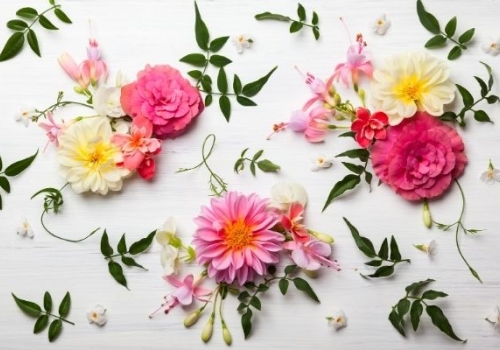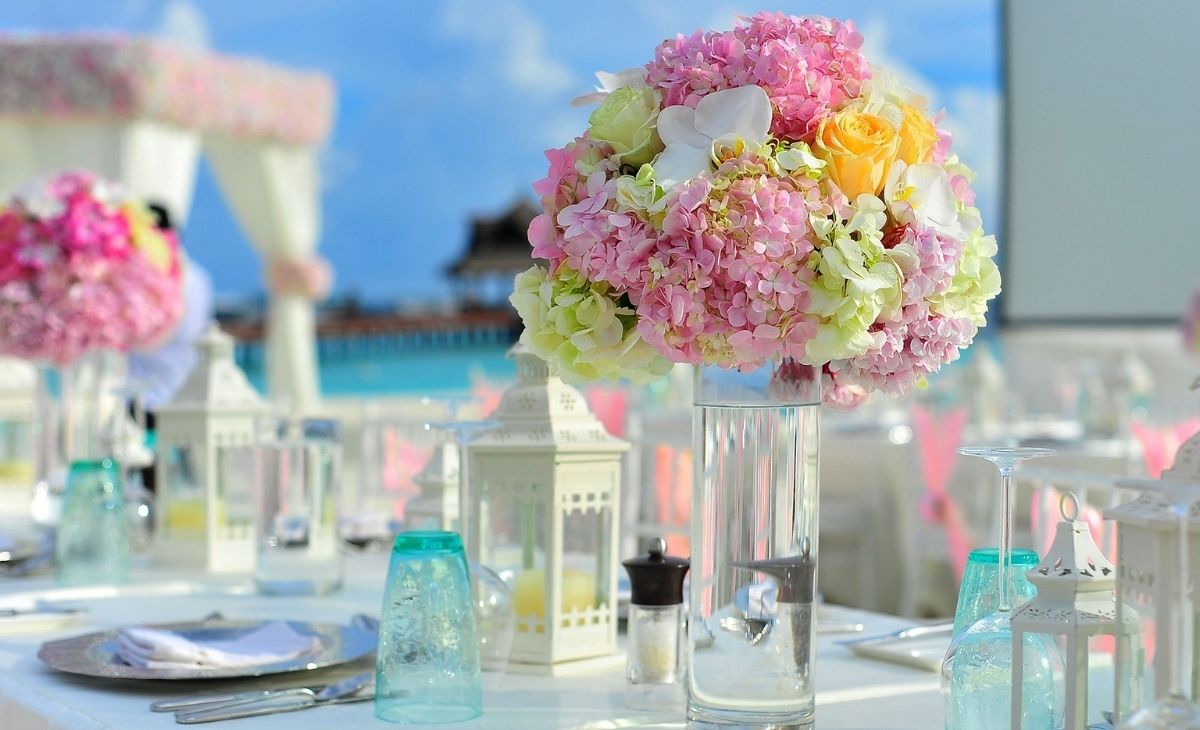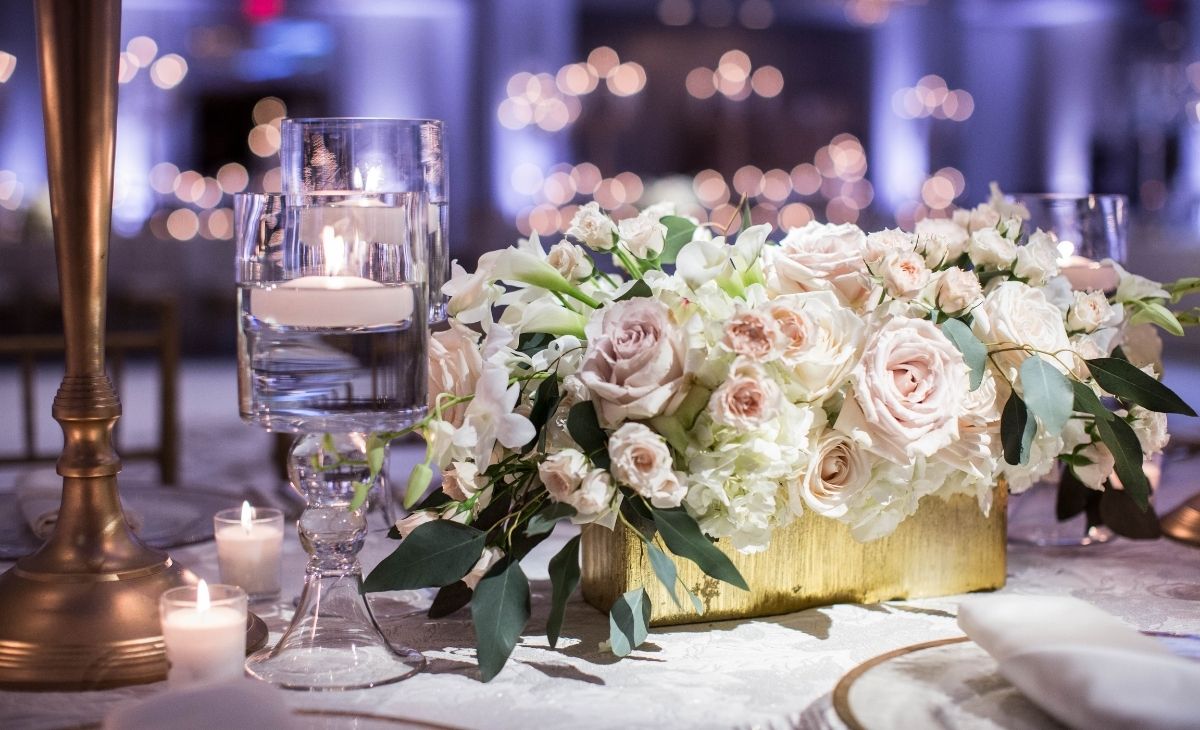A Complete Guide to Caring for Flowers on Board Superyachts

One of the most popular topics we have on my Facebook group Yacht Stewardess and Steward Tips is centred around flowers, flower selection and care – after all, they play such huge part when it comes to creating the ambiance of a superyacht, but with so much information to navigate, arranging the perfect display can be a challenge.
To help, here we’ll discuss some expert ways to arrange and care for flowers, which long-lasting flowers to choose, and how to care for them to prolong their beauty during a long guest trip. We will also be looking at using some additional options, such as using succulents and preserved flowers.
Caring for fresh flower arrangements
- Start with a clean vase and ensure the water is very cold.
- Add one of the following to the water: 10 ml bleach, 10 ml Sprite, 10 ml sugar, a copper coin, or use 1/2 tap water and 1/2 soda water and a few ice cubes when filling the vase.
- Remove leaves that will be below water level.
- Cut 2 - 3cm off the bottom of the stems under water and immediately put in vase/oasis (use sharp plant scissors).
- Arrange in the vase. (Additional tip: tape clear tape or floral tape around the top of the vase in a criss-cross grid pattern (squares about 2cm x 2cm wide) and stick stems into the various openings of the tape – this will keep your flowers in place while you arrange them. You can remove the tape after the arrangement is complete, as flowers will stay in place).
- Water the flowers every day and change the water out every second day. In hot areas, I also add a few ice cubes once a day.
- Avoid draughts and windy areas, as well as air conditioners.
- Avoid direct sunlight. Do not place flowers or orchids near fruit bowls as fruit gives off ethylene gas, which will make the flowers die sooner. Also remember if you use fruit in flower arrangements, those flowers will not last long, so it is best to do just before the end of a guest trip.
- Immediately remove dead or wilting flowers.
Additives to water and ideas on how to prolong your flowers’ beauty
To make fresh cut flowers last longer, use any one of the following suggestions:
-
2 tablespoons of vinegar/lemon juice and 1 teaspoon sugar.
-
A little sugar and a pinch of salt.
-
Add a copper coin in the vase and keep it there until the flowers are thrown out.
-
Add about 10ml of vodka.
-
Add an aspirin in the water.
-
Add a few drops of tea tree oil in the water, as it will reduce bacteria growth.
-
Add 5ml of rubbing alcohol to the water.
Remember to change the water every couple of days. For exterior flowers, I definitely recommend that the flowers are watered at least twice a day.
If you have a walk-in fridge with some extra space, it is always best to allow your flowers to stay there overnight – some larger yachts even have a walk-in fridge just for the flowers. Again, be careful not to store your flowers in a fridge containing fruits. If you are not lucky enough to have a walk-in with any room for the flowers, at least ensure that the exterior flowers are brought in each night to sleep in the cool air in the interior.
When making a flower selection, focus on buying/ordering stronger flowers that will last longer, rather than for instance, tulips (see more about this later in the article).

Some handy tips for flower arrangements
How to treat your stems: Anything that looks the slightest bit floppy should have its stem seared in a pot of boiling water for 30 seconds (if you have a woody stem, give it a bit longer – for instance, for Chrysanthemums). To do this, place some boiling water in a mug and put the stems in, but only place 10 per cent of the stem in the water. Remember not to leave them in too long, as they will actually start cooking. If your stem is quite short, you should shield the flower from the steam as this will cause it to wilt and die. You can do this by wrapping the flower in a piece of brown paper.
How to cut your flowers: If possible, buy florist scissors (or good quality secateurs) as these have stronger blades than normal scissors and will achieve a better finish when cutting. Remember to cut your stems diagonally. This ensures the flower lives as long as possible and can suck up the maximum amount of nutrients from the water. You should also remove any low-level leaves that will be hidden in the flower vase to give stems more room.
What to put in the water: Just add a touch of bleach and sugar to your water. This will prevent bacteria growing and killing your beautiful blooms. About 2 teaspoons of each is ample.
Fool proof arrangements: A simple way of arranging your flowers is to place a single stem flower into narrow neck bottles and scatter a few of them on your breakfast table. This creates an elegant look that is easy to maintain and works especially well with gerberas.
Apart from the classic clear crystal vase, turquoise or acid green are great colours for vases. They complement any flowers. If you are planning on using a clear vase, then maybe add some coloured pebbles/marbles to the bottom to enhance the look and will give your flowers a boost.
Use a clean vase: Many people stick their flowers into the nearest vase to hand without checking it is clean. For your flower arrangement to look absolutely stunning, it is important that your vase is sparkling clean. To remove any stains from your glass/crystal vase, use dentures or Milton tablets along with a bottle brush. Make sure you rinse and dry properly to avoid contamination and smudges.
The best plants to use for foliage: Always start with the foliage. Don’t go too heavy-handed as the flowers should remain the main attraction. Euphorbia oblongata is a fantastic acid green colour and is often used by florists. A foliage I NEVER go without is ruscus as it lasts forever and always adds elegance, as well as a direct contrast and brightness to the arrangement. Your choice of foliage will depend on your yacht’s location and there are hundreds of beautiful choices around the world. Choose foliage with a robust nature, not messy (I find ferns become very messy within a few days) and strong standing stem.
Flower arranging mistakes
The art of flower arranging can be tricky – just figuring out where to begin can leave your head spinning. But, every steward/ess and guest alike knows that the perfect centrepiece can take a table setting to another level. So how can you bring your arrangements to the next level? Beware of the following mistakes…
-
Using too many different kinds of flowers: Select on one or two ‘focus flowers’ - these are normally large and make a statement (like protea or strelitzia). Once you have those showstoppers selected, hone in on just a few additional varieties to complement them. You will end up with a much better-looking bouquet if you choose just a few types that go well together.
-
Overly mix-and-matching: The colours don't need to exactly match, but bouquets should ALWAYS have a transition colour to bring the different shades together. Plus, think about how you're combining flower shapes and textures – the key is to find a balance. I always ensured I knew exactly in which cabin I was going to use which flowers, as I believe it is important to select the same colour profile as your cabin’s inherent and primary colours.
-
Loosely arranging blooms: When making an arrangement, the word to keep in mind is "cluster." I find that the magic number is three. Pull a few elements together in clusters of three. They will naturally draw your eye and attention. Bonus tip: try positioning the clusters at the edge of your vase for added wow-factor.
-
Cutting the stems straight: Be sure to always cut at a diagonal angle. Giving your stems an angled cut creates a 'straw-like' hydration system and ensures no bacteria grows on the bottom of your vase.
-
Not changing the water often enough: Change the water every other day and use a little flower food like Sprite to keep your flowers happy. Also keep them in a cool, shady area, rather than in direct sun or close to an air conditioner.

More general tips
Why you should cut flower stems
Every time you buy fresh flowers, make sure to trim off the ends of the stems. Cutting the stems gets rid of any dead part of the flowers, while doing it underwater ensures that air bubbles won’t get caught in the stems while cutting. Without air bubbles, water travels up the stems more easily, keeping your bouquet fresher longer. Ensure you remove any of the stem leaves that will be underwater in your vase. If left underwater, leaves rot quickly and give off an unpleasant odour. It is important to also remove rose thorns prior to using roses in any arrangements. This is best done by cutting them with secateurs, rather than a thorn stripper, as the stripper can damage the stem, creating bacteria in your water and causing the flowers to die faster.
How often should I change water in the flower arrangement?
To prolong the life of fresh flowers, change the water at least every two days (even every day if you have the time). Add some flower food like lemon juice or Sprite or a copper coin (see more suggestions elsewhere).
Vase too big?
Is your bouquet spreading out too much in the vase? For a simple fix, just use a green hair elastic or green floral tape to hold the stems together. If the opening of your vase is too large, make a grid by crisscrossing clear tape over the top. And finally, if you've accidentally cut your stems too short for your vase, cut a length of a straw and slip it over the end of the stem to artificially extend it. I also often use clear glass marbles/pebbles or river stones at the bottom of a vase, this will keep the stems secure.
Watering flower arrangements
In my experience, a large turkey baster is best to use to avoid disturbing your beautiful arrangement or oasis flower arrangement. You can also dispose of old water first by sucking up the remaining water with the baster.
How to prevent flowers from wilting
If you are working with flowers that quickly wilt, I suggest you wrap green flower wire around the stems first – this works especially well with gerberas, tulips and arum lilies.
Transportation trick
Visiting the flower market to select some flowers to be transported back to the yacht? To easily transport cut flowers, hold a Ziploc under a faucet and fill it with some water, then pull the opening over the stems of your flowers and secure with a rubber band. It is a neat way to let them have a drink in transit.
Read part 2 of this article here: Flowers with Longevity - Blooms for Long Guest Trips

Post your comment
You cannot post comments until you have logged in.
Login to post a commentComments
No one has commented on this page yet.
RSS feed for comments on this page | RSS feed for all comments